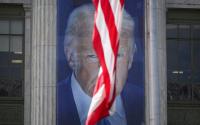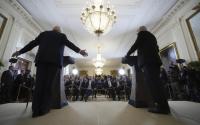2 January 2007Mahir Ali
In the end, there was no closure, just another unnecessary act of violence. By the time a noose was placed around his neck and the plank he stood upon wrenched away with undue haste, Saddam Hussein had long since ceased to matter much as far as Iraq’s future was concerned. His irrelevance did not suddenly manifest itself on the day of the spider-hole charade three years ago: it became reasonably clear the moment the conquest of his country compelled him to go into hiding. Thenceforth the fate of Iraq was in the hands of the conquerors. Or so they thought.
Back in 2003, Saddam received some of the credit for the incipient resistance to foreign occupation: it would become considerably more manageable, it was suggested, once the monster was apprehended. But the former strongman quite clearly wasn’t in charge of anything when they found him. The violence steadily deteriorated afterwards. More than 100 US soldiers were killed in December 2006, making it the worst month thus far in terms of American casualties and taking the overall toll past the psychologically damaging figure of 3,000. Much worse, the monthly casualty rate for the occupying forces roughly equals the daily death toll for Iraqis.
The Shia-Sunni violence has unofficially been designated a civil war, but what’s happening in Iraq is obviously not just a civil war. The Baathist influence on the insurgency was exaggerated from the outset, just like Al Qaeda’s role, in order to make it easier for the resistance to be written off as the handiwork of dedicated evildoers. It was never quite as simple as that. Or perhaps it was, in a sense. As the poet W.H. Auden, writing about the origins of the Second World War, pointed out: “I and the public know/ What all schoolchildren learn,/ Those to whom evil is done/ Do evil in return.”
It isn’t particularly difficult to come to terms with the fact that a substantial proportion of Iraqis - mainly Shias and Kurds - considered Saddam’s exit cause for jubilation. After all, the numerous brutalities of his atrocious regime were directed mainly towards those two sections of the population. An unpleasant and violent childhood made a thug and, reputedly, a murderer out of Saddam by the time he was in his teens. The key to his rapid rise through the ranks of the Baath party was ruthlessness. By the time the party acquired power in 1968, he was already a feared entity. When he formally rose to the top 11 years later, one of his first acts was a pitiless purge of the Baath leadership, in a nod to his hero Josef Stalin.
Saddam brooked no dissent, nor did he shrink from mass reprisals. The aggression against Iran was criminal folly on a grand scale: that didn’t prevent Iraq’s Arab neighbours as well as the Reagan and Thatcher administrations from supporting his war effort: the CIA supplied satellite surveillance photographs of potential targets, and even the ingredients for the chemical weapons he used against Iranians and the Kurdish population of Halabja came from Western sources. Whereas Iran welcomed Saddam’s execution, at least some Kurds were more circumspect, regretting the fact that he was removed from the scene at the opening stages of his trial over charges relating to the genocidal Anfal campaign.
And there, perhaps, lies the rub. Or one of them at any rate. The Americans couldn’t have been particularly keen on court proceedings dealing with the period during which they were all too willing to bolster the Saddam administration. The Dujail massacre, which constituted the basis for Saddam’s conviction and execution, was a relatively minor bloodbath, occasioned by an assassination attempt organized apparently by the Dawa party, now led by prime minister Nouri Al Maliki. The victims were all Shias. For all that, the tawdry trial fell well short of acceptable legal norms in both evidentiary and procedural terms. The appeal was pure farce. And the unseemly speed with which the sentence was carried out signified that justice wasn’t the main item on the agenda.
Saddam’s final moments reinforced the impression of pure retribution. The official video of the execution was broadcast without the audio component, but an amateur effort found its way around the world in no time, making it clear that the deposed dictator was subjected to taunts from the guards and the assembled audience, including arguably blasphemous invocations of militia leader Moqtada Al Sadr, and that the noose tightened around his neck while he was halfway through the kalima.
According to a report in Monday’s New York Times, American officials in Iraq were alarmed by the Maliki government’s impatience, but couldn’t stand in its way. That seems like a post-hoc attempt to put a bit of distance between the US and the puppet regime in Baghdad, the implication being that the barbaric aspect of the exercise was an Iraqi initiative. This ploy is unlikely to work, given that the facade of Iraqi sovereignty is clearly a myth. As the NYT report points out, Saddam’s final public appearance was allowed “to deteriorate into a sectarian free-for-all that had the effect ... of making Mr Hussein, a mass murderer, appear dignified and restrained, and his executioners, representing Shiites who were his principal victims, seem like bullying street thugs”. The Americans didn’t do anything about it because they did not wish to.
Besides, it isn’t easy to inject a civilized note into something as primitive as state-sanctioned murder. It has been argued that Saddam’s end was a befitting one, given the man’s nature and his past. It has also been said that, for all its flaws, his trial was superior to the legal proceedings faced (or not, as the case may be) by his victims. Iraq under Saddam could, no doubt, be an extremely nasty place for those who fell foul of his regime. But the preceding arguments serve only to buttress the conclusion that not much has changed since those days, apart from the faces and sectarian affiliations of those in power.
It is quite possible that Saddam’s poise at the point of death was a corollary of the narcissism and arrogance that determined his course in life. “Nothing in his life,” as Shakespeare might have put it, “Became him like the leaving it: he died/ As one that had been studied in his death/ To throw away the dearest thing he owed/ As ‘twere a careless trifle.” But Shakespearean tragic heroes require a redeeming quality or two, and in Saddam’s case these are hard to come by. The mantle of martyrdom does not sit easily on his shoulders. He obviously shares responsibility for the sectarian divide that is tearing Iraq apart, although the gulf has deepened in the post-Saddam phase. The manner of his death will make it much worse.
A veracious catalogue of Saddam’s crimes could have served Iraq well, but that could have been put together only in an independent nation. That opportunity has now been lost: no one knows how many secrets he has taken to his grave. The persecution of Saddam was also jarring because, as far as Iraq is concerned, worse offenders have come to light in recent years. As Robert Dreyfuss points out in the US periodical The Nation, “Saddam Hussein was blamed by his fiercest critics ... of killing 300,000 Iraqis during his 35-year rule (1968-2003). In less than four years, George W. Bush has more than doubled that, with no end in sight. As war criminals go, Bush wins hands down.”
Saddam’s last rites in his birthplace, Awja, coincided with those for a former US president, Gerald Ford, who died last week at the age of 93. Ford was one of the only unelected presidents the US has had: he was appointed vice-president by Richard Nixon after Spiro Agnew resigned over a tax scandal, and became president when Nixon was run over by the Watergate crisis in 1974. Ford had to deal with the aftermath not only of Watergate but also of the American defeat in Vietnam. Not surprisingly, he avoided foreign adventures despite being surrounded by hawks.
In an embargoed interview with The Washington Post’s Bob Woodward two years ago, Ford expressed profound disagreement with Bush’s war on Iraq. His tenure was brief (he lost the 1976 election to Jimmy Carter, not least because he indemnified Nixon, an old friend, against all Watergate-related charges), but that shouldn’t detract from his status as the least harmful US president in the postwar era. It is difficult to forgive him, however, for a pair of sinister legacies. One of them is called Donald Rumsfeld. The other is known as Dick Cheney. Both of them served Ford as chief of staff, and Rumsfeld even did a preliminary stint as defence secretary. At a stretch, Ford could also be accused of helping to launch the Bush dynasty by ensconcing W’s dad at the helm of the CIA.
This is the same dad whose assassination Saddam allegedly tried to arrange, and the younger Bush has more than once given the impression of nursing a vendetta. It’s over now, but he still has Iraq on his hands. A week from today he is expected to come up with a fresh plan. Whether it will include anything other than a temporary troop surge remains to be seen. Bush took great pains, meanwhile, not to strike too triumphant a pose over Saddam’s fate. He described it as a milestone, but didn’t elaborate. There are only two possibilities: if it’s a milestone, it’s either on the Highway to Hell or the Road to Perdition.
http://www.zmag.org/content/showarticle.cfm?SectionID=15&ItemID=11759






